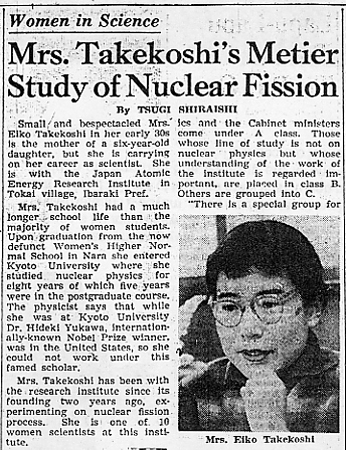MRS. TAKEKOSHI'S METIER STUDY OF NUCLEAR FISSION
from The Japan Times
 The Japan Times, March 8, 1959. Small and bespectacled Mrs. Takekoshi Elko in her early 30s is the mother of a six-year-old daughter, but she is carrying on her career as scientist. She
is with the Japan Atomic
Energy Research Institute in
Tokai village, Ibaraki Pref.
Mrs. Takekoshi had a much
longer school life than the
majority of women students.
Upon graduation from the now
defunct Women's Higher Normal School in Nara she entered Kyoto University where she studied nuclear physics for
eight years of which five years
were in the postgraduate course.
The physicist says that while
she was at Kyoto University
Dr. Hideki Yukawa, internationally-known Nobel Prize winner, was in the. United States, so she could not work under this
famed scholar.
Mrs. Takekoshi has been with the research institute since its founding two years ago, experimenting on nuclear fission process. She is one of 10
women scientists at this institute.
The young scientist's name
became known to the public when a photo of nuclear fission caused by gamma rays was presented to the physics society in October 1957. She is reluctant about mentioning her achievement, saying she does not want
to talk about her past accomplishment.
"With science there is no end
in research and my study on nuclear fission will never be completed," states the young
scholar.
Explaining about the work at
the research institute she continues that the scholars at the institute are in a kind of dilemma. The people who have given
money to the institute expect to gain quick results from experiments which can be applied to industries, but theoretical
study cannot be immediately
put to actual use, a fact which
businessmen do not seem to
understand, "The institute needs
a great deal of funds and the
public who do not know physics feel that the institute is wasting money unless tangible
results are produced," comments Mrs. Takekoshi.
There are many visitors to
the institute, many of whom are ignorant of nuclear energy and the work being done at
the institute. Sometimes she feels that too much time is taken up showing guests
around. With good humor Mrs.
Takekoshi explains that the
visitors are classified into three
groups, A, B and C. Scholars
and students of nuclear physics and the Cabinet ministers come under A class. Those
whose line of study is not on
nuclear physics but whose
understanding of the work of
the institute is regarded important, are placed in class B. Others are grouped into C.
"There is a special group fornewsmen, because we feel it
important that our work be interpreted to the public through the papers," notes the scientist. Visitors must send in applications beforehand stating their
names and professions. Visitors' days are limited to Wednesday and Saturday afternoons.
Mrs. Takekoshi in her private
life is the wife of Hidekuni Takekoshi, also a physicist working at the institute. They met and married while at Kyoto University. Their only daughter stays with her grandmother in Tokyo and joins her parents twice a month when they come to To
kyo. Mrs. Takekoshi, however, does not think it disadvantageous to live apart from her
daughter as she is well taken
care of by her mother-in-law
and brother's family.
.........................
Reference
Tsugi Shiraishi. "Women in Science--Mrs. Takekoshi's Metier Study of Nuclear Fission." The Japan Times, March 8, 1959.
| 